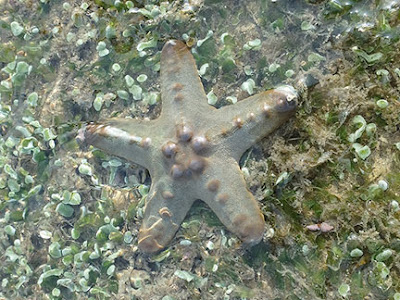We estimate about 50% of the hard corals and 50% of the leathery soft corals are bleaching. But we also notice about 5-10% of corals have died recently. This is a lot more than what we saw on our last survey just about a month ago in May 2016.
The reefs of Kusu Island are just across from the main business district on the mainland.
Even at first light, we could see the bleached corals.
Mass coral bleaching in Singapore is not unexpected. From the NOAA's coral reef watch satellite monitoring, Singapore is in the yellow Watch zone. Where we should be prepared for mass coral bleaching.

What is coral bleaching?
Coral are colonies of tiny animals called polyps. Each polyp lives inside a little hard skeleton. The huge colony is made up of the skeletons of countless polyps. The polyps of all reef-building hard corals harbour microscopic, single-celled algae (called zooxanthellae). The polyp provides the zooxanthellae with shelter and minerals. The zooxanthellae carry out photosynthesis inside the polyp and share the food produced with the polyp. Corals generally have white colour skeletons, which is believed to assist in photosynthesis by reflecting light onto the zooxanthellae.
When there is massive loss of zooxanthellae in a hard coral colony, the polyps become colourless and the underlying white skeleton shows through. Thus patches of the colony appear pale, white or 'bleached'. The polyps are still alive and the hard coral is not dead (yet).
Hard corals harbouring zooxanthellae live close to the upper limit of temperature tolerance. Thus a temperature increase of even 1-2 degrees centigrade can result in bleaching. It is believed that global warming will lead to massive bleaching.
Once the cause of bleaching is removed, however, polyps may eventually regain zooxanthellae (which live freely in the water) and thus recover their health.
But prolonged bleaching can kill corals and seriously damage large sections of a reef. Factors believed to cause bleaching include: temperature fluctuations (too high or too low), excessive exposure to ultraviolet light, excessive sedimentation in the water, changes in salinity and disease. It is generally believed that bleaching is related to unusual prolonged temperature increases in the seawater.
Bleaching corals are also obvious at the Kusu Island jetty, where the reef edge plunges away.
Here's another view of the bleaching corals at the reef edge.
Another view of the bleaching corals near the jetty.
A very large coral colony on the reef edge, bleaching.
Corals also grow inside the swimming lagoon. The patch of Branching montipora seemed alright, although there were dead corals among them.
It was good to see that not all the leathery soft corals were bleaching. About 50% seemed alright. I also saw some clumps of Asparagus flowery soft corals that were not bleaching.
As usual, there were corals that were not bleaching next to corals that were. As well as corals that look like they died recently.
There were lots of Magnificent sea anemones and none of them were bleaching. There were also many Haddon's carpet anemones and Giant carpet anemones and I only saw a few bleaching.
Here's another series of photos of corals that are partially bleaching and partially dead and bleaching or not bleaching.
The most amazing encounter for me was this very very long worm that we saw when we first arrived on the shore before dawn. It looks like an Acorn worm! It was already burrowing back into the sand, so after a few photos, we left it alone. At sunrise, we no longer saw it on the shore.
There are seagrasses in the swimming lagoons of Kusu Island. Some patches of Spoon seagrass (with tiny leaf blades), two small clumps of Tape seagrass outside the seawall, and some patches of Needle seagrass too.
How nice to see a baby Knobbly sea star in the seagrass meadows.
It was heartbreaking to see trash thrown onto the corals outside the seawall. This looks like a table and BBQ stuff dumped from the seawall. One piece landed near a bleaching coral, another piece next to a dying coral. At least today, we did not come across a fish net like on our last survey in May 2016.
While there is not much we can do when our corals start bleaching, we can do a lot to stop other stresses that impact our reefs so the corals are in better health and don't succumb after bleaching.
High res photos of mass coral bleaching in Singapore for free download on wildsingapore flickr
Others on this trip: Jonathan Tan, Yi Feng, Nicholas Yap.





















